 Rufous-crowned Sparrows were out in force this morning. I heard them singing before sunrise along with Common Nighthawks and Chuck-will's Widows from the Park Office (sunrise photo). A Rufous-crowned Sparrow continues to claim territory above Twin Falls.
Rufous-crowned Sparrows were out in force this morning. I heard them singing before sunrise along with Common Nighthawks and Chuck-will's Widows from the Park Office (sunrise photo). A Rufous-crowned Sparrow continues to claim territory above Twin Falls.I still have a Louisiana Waterthrush on territory along Twin Falls Creek and the nesting Blue Grosbeaks now have fledged young. The other nest I was following is the Acadian Flycatcher nest #2 at Tobacco Creek Seep. There is one nestling which both parents are feeding. I believe this young will be fledged within the week. I also saw one Acad ian Flycatcher fledgling from nest #1, along with an adult in the Tobacco Creek drainage.
ian Flycatcher fledgling from nest #1, along with an adult in the Tobacco Creek drainage.
 ian Flycatcher fledgling from nest #1, along with an adult in the Tobacco Creek drainage.
ian Flycatcher fledgling from nest #1, along with an adult in the Tobacco Creek drainage. At nest box #4 early in the morning I watched a Skunk rooting around and finally retire for the day in its den at the lower right base of this Live Oak tree root (photo). Directly after the skunk observation, I heard rustling in the grasses downhill. Two Armadillos were running around the  hillside playing. I thought for a moment I was contending with wild pigs.
hillside playing. I thought for a moment I was contending with wild pigs.
 hillside playing. I thought for a moment I was contending with wild pigs.
hillside playing. I thought for a moment I was contending with wild pigs. Throughout the rest of the year I will continue to mountain bike and bird watch at Pedernales Falls State Park. However, I may only be visiting once or twice a month. Stay tuned as I will post any wildlife encounters.
The plant photo is Caster Bean, cultivated in Texas for its oil and as an ornimental. The plant is native to Ethiopia and all parts of the plant are poisoness. It is common along Twin Falls Creek. It grows near the water and can reach 5' tall. It has a cockle bur-like seed. 
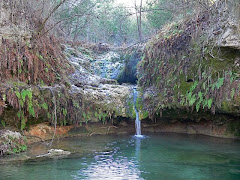
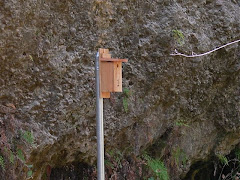
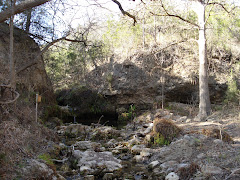
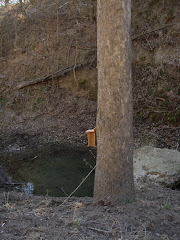
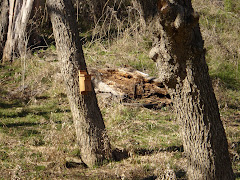




No comments:
Post a Comment